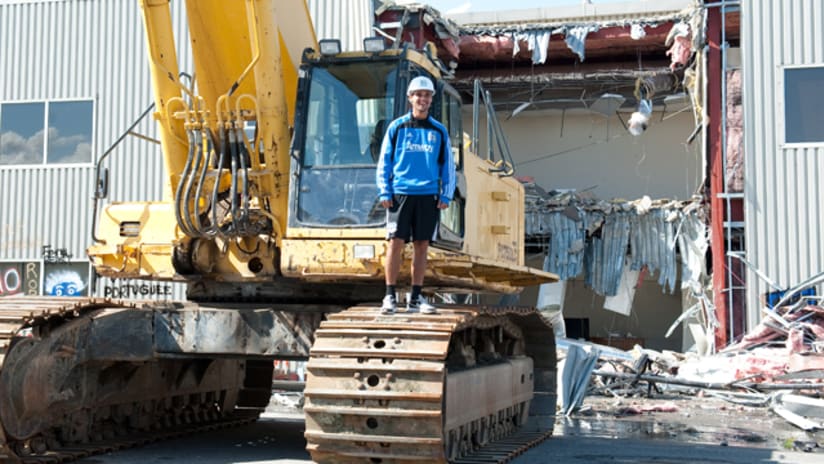<a href="http://www.mlssoccer.com/road-trip-first-kick"><img src="//sanjose-mp7static.mlsdev.net/mp6/2011_road_trip_adidas_logo.png" alt="" width="180"></a><p>Join MLSsoccer.com’s <strong>Jackie Pickering</strong> and <strong>Nick Firchau</strong> as they travel from LA to Vancouver, checking in on all the West Coast teams, meeting with fans, and stopping into adidas HQ in Portland to pick up the game ball for First Kick on March 15 at Qwest Field.</p><p><img src="//sanjose-mp7static.mlsdev.net/mp6/pickering-small.jpg" alt="" width="90" height="90"><img src="//sanjose-mp7static.mlsdev.net/mp6/firchau-small-mug.jpg" alt="" width="90" height="90"></p><a href="http://www.mlssoccer.com/road-trip-first-kick"><strong>Follow the Road Trip here</strong></a><br> |
SAN JOSE, Calif. – The rubble goes into three distinct piles: wood, concrete, metal.
The machine doing the sorting is a heavy-duty, no-frills industrial excavator that lowers and lifts its gigantic metal claw 40 feet above the wreckage, then somehow delicately peels off a rusted pipe or a scrap of aluminum siding away from the remnants of a 1920s-era warehouse wall.
The process goes on like this, deliberate demolition of a building now tagged with a message of urgency hastily scrawled in blue graffiti: “Build It Now!”
The site of the future San Jose Earthquakes stadium is a steady work in progress now, only a week after the franchise first proudly punched a hole into the wall. The building that produced agricultural equipment for nearby orchards in the 1920s and later rolled out military vehicles for World War II is getting a serious soccer makeover.
“We actually had the guys in here playing a game the other day,” Earthquakes president David Kaval says, pointing to a concrete wall at one end of a building that from the inside resembles a hollowed out air cargo terminal. “That’s what we used as the goal, because that’s where it’s going to be.”
WATCH: Kaval discusses demolition with Nick Firchau
Kaval walks to the demolition site and looks over the wreckage, a front office executive focused on building this club and thrilled to watch the excavator destroy, every day spent sorting the mess done in the name of housekeeping for the Earthquakes, who’ve been perhaps the league’s most nomadic team since the early days of the league.
But beginning last week – when superstar Chris Wondolowski hopped inside the excavator for a photo shoot to celebrate the first step of the demolition – the Quakes took one of the first real strides to finally building a home of their own.
Team officials expect the demolition of the building to be complete within 12 weeks, then leaving a vacant lot adjacent to the club’s practice field. That facility – a sparkling, $1.4 million patch of grass where the Quakes rehearsed for their run to the Eastern Conference Championship last season – is an anomaly here, bordered on one side by a busy commuter train line and on the other by a vacant, pockmarked parking lot used to train novice motorcycle riders.
[inline_node:330237]But here’s what’s coming: commercial development, the soccer-specific stadium and four adjacent practice fields stretching into the distance. Earthquakes technical director John Doyle can nearly see it all now.
“On a personal note, I grew up here,” Doyle said. “And we’ve never had a stadium. We’ve never even had a practice field. It’s like a dream.”
The Quakes famously lost their franchise in 2005 to Houston, a city that successfully dangled the carrot of a new stadium and, after the team spent more than half a decade under the lights at Robertson Stadium, will deliver it in 2012. When the Quakes were finally relaunched in 2008, there was immediate talk of building the stadium that had eluded them in the past, but a sour economy crippled those hopes almost instantly.
To try and adequately sum up the angst of Quakes fans that lost their club over the stadium issue (and still openly loathe the Dynamo whenever the teams meet) is futile, but to understand what a new stadium would mean now is easily understood in Doyle’s voice as he waves his hand over the landscape about the change.
“You can do camps, you can host clinics, you can host tournaments. You can do everything,” he said. “You can see a 9-year-old go from those fields to the first team on the stadium field.
“If we can do that,” he says, rubbing his arm, “that gives me chills.”
The club is hopeful to sort out the building permit issues for the new stadium this summer, with hopes of breaking ground soon after. The stadium would take roughly a year to build, according to Kaval.
But all that is still months away, at the least. The scene now is all scrapes and screeches of metal on asphalt, the destructive thud of pulverized concrete and the twisting and turning of the metal claw lifting debris from the path to the future.
“It’s like we were stuck in traffic,” Kaval says, echoing a familiar scenario for Silicon Valley locals. “Now you can tell we’re finally moving.”

